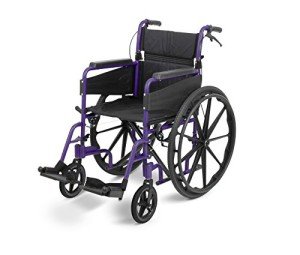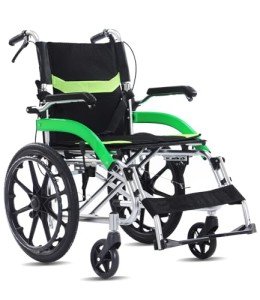See What Self Control Wheelchair Tricks The Celebs Are Utilizing
페이지 정보
작성자 Alfie Rosenhain 작성일 25-02-04 16:23 조회 4 댓글 0본문
 Types of self propelled wheelchair ebay Control Wheelchairs
Types of self propelled wheelchair ebay Control Wheelchairs Many people with disabilities utilize lightweight self propelled wheelchairs control wheelchairs to get around. These chairs are great for everyday mobility, and are able to easily climb hills and other obstacles. They also have large rear shock-absorbing nylon tires that are flat-free.
Many people with disabilities utilize lightweight self propelled wheelchairs control wheelchairs to get around. These chairs are great for everyday mobility, and are able to easily climb hills and other obstacles. They also have large rear shock-absorbing nylon tires that are flat-free.The speed of translation of the wheelchair was calculated using a local potential field method. Each feature vector was fed to an Gaussian encoder that outputs a discrete probabilistic spread. The evidence accumulated was used to drive the visual feedback and a signal was issued when the threshold was reached.
Wheelchairs with hand-rims
The type of wheel that a wheelchair is using can affect its ability to maneuver and navigate different terrains. Wheels with hand-rims reduce wrist strain and increase comfort for the user. Wheel rims for wheelchairs can be made from aluminum, steel, or plastic and come in different sizes. They can be coated with vinyl or rubber to provide better grip. Some are ergonomically designed, with features such as an elongated shape that is suited to the grip of the user's closed and broad surfaces to provide full-hand contact. This lets them distribute pressure more evenly and reduce the pressure of the fingers from being too much.
Recent research has revealed that flexible hand rims can reduce the impact forces, wrist and finger flexor activities in wheelchair propulsion. They also provide a larger gripping surface than standard tubular rims permitting users to use less force while still retaining the stability and control of the push rim. These rims are available at most online retailers and DME providers.
The study's findings revealed that 90% of those who had used the rims were satisfied with the rims. It is important to keep in mind that this was an email survey of those who purchased hand rims at Three Rivers Holdings, and not all wheelchair users suffering from SCI. The survey did not assess any actual changes in pain levels or symptoms. It simply measured the extent to which people noticed a difference.
There are four models available The big, medium and light. The light is a small-diameter round rim, whereas the big and medium are oval-shaped. The prime rims have a slightly bigger diameter and an ergonomically contoured gripping area. All of these rims are placed on the front of the wheelchair and can be purchased in various colors, ranging from naturalwhich is a light tan shade -to flashy blue green, red, pink or jet black. They also have quick-release capabilities and can be removed for cleaning or maintenance. In addition, the rims are coated with a vinyl or rubber coating that protects hands from slipping on the rims and causing discomfort.
Wheelchairs with tongue drive
Researchers at Georgia Tech have developed a new system that lets users move a wheelchair and control other digital devices by moving their tongues. It is comprised of a tiny magnetic tongue stud that transmits signals from movement to a headset with wireless sensors and the mobile phone. The smartphone converts the signals into commands that can control the wheelchair or other device. The prototype was tested with disabled people and spinal cord injured patients in clinical trials.
To assess the performance, a group physically fit people completed tasks that assessed speed and accuracy of input. Fitts’ law was used to complete tasks, such as keyboard and mouse usage, and maze navigation using both the TDS joystick and Self Control wheelchair standard joystick. The prototype was equipped with an emergency override button in red, and a friend accompanied the participants to press it when needed. The TDS worked just as well as the traditional joystick.
In a separate test that was conducted, the TDS was compared to the sip and puff system. This lets people with tetraplegia control their electric self propelled wheelchair wheelchairs by sucking or blowing into straws. The TDS completed tasks three times faster, and with greater accuracy, than the sip-and-puff system. The TDS can drive wheelchairs more precisely than a person with Tetraplegia, who steers their chair with a joystick.
The TDS could monitor tongue position to a precise level of less than one millimeter. It also included cameras that could record the eye movements of a person to detect and interpret their movements. It also included security features in the software that checked for valid user inputs 20 times per second. If a valid user signal for UI direction control was not received for a period of 100 milliseconds, the interface module automatically stopped the wheelchair.
The team's next steps include testing the TDS on people who have severe disabilities. To conduct these tests they have partnered with The Shepherd Center which is a critical care hospital in Atlanta as well as the Christopher and Dana Reeve Foundation. They are planning to enhance the system's sensitivity to ambient lighting conditions, add additional camera systems, and allow repositioning for different seating positions.
Joysticks on wheelchairs
With a wheelchair powered with a joystick, clients can control their mobility device using their hands without needing to use their arms. It can be positioned in the middle of the drive unit or on either side. The screen can also be added to provide information to the user. Some screens have a big screen and are backlit to provide better visibility. Some screens are smaller and contain symbols or pictures to assist the user. The joystick can be adjusted to suit different hand sizes grips, sizes and distances between the buttons.
As the technology for power wheelchairs advanced and advanced, clinicians were able create driver controls that let clients to maximize their functional potential. These innovations also allow them to do so in a way that is comfortable for the user.
A standard joystick, for instance, is an instrument that makes use of the amount of deflection in its gimble to produce an output that increases as you exert force. This is similar to the way that accelerator pedals or video game controllers work. However, this system requires good motor function, proprioception, and finger strength to be used effectively.
A tongue drive system is a different kind of control that makes use of the position of the user's mouth to determine the direction to steer. A magnetic tongue stud transmits this information to a headset which can execute up to six commands. It is a great option for people with tetraplegia and quadriplegia.
Some alternative controls are easier to use than the traditional joystick. This is especially useful for users with limited strength or finger movements. Some controls can be operated using only one finger and are ideal for those with little or no movement in their hands.
In addition, some control systems have multiple profiles that can be customized for the needs of each user. This is important for those who are new to the system and may need to adjust the settings regularly when they feel tired or experience a flare-up in a disease. This is helpful for experienced users who wish to change the parameters set for a particular setting or activity.
Wheelchairs with steering wheels
self propelled wheelchairs uk-propelled wheelchairs are made for those who need to move around on flat surfaces as well as up small hills. They come with large rear wheels for the user to grasp as they propel themselves. Hand rims allow the user to utilize their upper body strength and mobility to guide a wheelchair forward or backwards. Self Control wheelchair-propelled chairs can be outfitted with a range of accessories including seatbelts and drop-down armrests. They may also have legrests that can swing away. Certain models can be converted to Attendant Controlled Wheelchairs, which permit caregivers and family to drive and control wheelchairs for users who require more assistance.
To determine the kinematic parameters, the wheelchairs of participants were fitted with three sensors that tracked their movement throughout an entire week. The gyroscopic sensors that were mounted on the wheels and fixed to the frame were used to measure the distances and directions of the wheels. To discern between straight forward movements and turns, periods of time in which the velocity differs between the left and right wheels were less than 0.05m/s was considered to be straight. Turns were then studied in the remaining segments, and the angles and radii of turning were calculated from the wheeled path that was reconstructed.
This study involved 14 participants. They were tested for accuracy in navigation and command latency. Using an ecological experimental field, they were required to navigate the wheelchair using four different ways. During navigation tests, sensors monitored the wheelchair's path throughout the entire route. Each trial was repeated twice. After each trial participants were asked to select which direction the wheelchair was to move.
The results showed that the majority of participants were able to complete tasks of navigation even although they could not always follow the correct directions. On average, self control wheelchair they completed 47% of their turns correctly. The other 23% were either stopped immediately after the turn, or wheeled into a subsequent turning, or replaced by another straight movement. These results are similar to those from earlier research.
댓글목록 0
등록된 댓글이 없습니다.